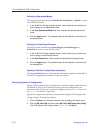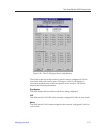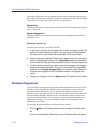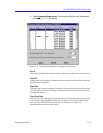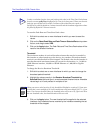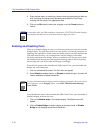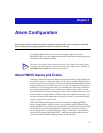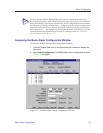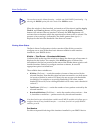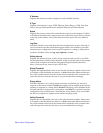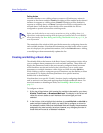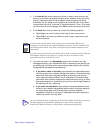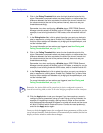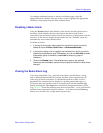
Alarm Configuration
3-2 Basic Alarm Configuration
Using the Advanced Alarms feature, you can deÞne custom alarms for almost any
MIB-II or RMON object, as long as it is present in the device Þrmware and its
value is deÞned as an integer (including counters, timeticks, and gauges). All
aspects of these alarms are user-selectable: thresholds can be established on either
the absolute or delta value for a variable; events can be conÞgured to create a log,
generate a trap, or both; and for Cabletron devices that support the Actions MIB,
events can also be conÞgured to perform any deÞned SNMP SET or series of SETs
on device objects. The Advanced Alarms feature also allows you to conÞgure any
events you wish to use in conjunction with the Packet Capture functionality. (For
more information on using the Packet Capture feature, see the RMON UserÕs
Guide included with your software.)
The Basic Alarms feature allows you to assign alarms to any interface type; using
the Advanced Alarms feature, you need only be sure to select variables
appropriate to the interface Ñ Ethernet for Ethernet, Token Ring for Token Ring,
etc. Ñ when deÞning your alarms.
Basic Alarm Configuration
Using the Basic Alarm ConÞguration application, you can deÞne both rising and
falling alarm thresholds for three selected MIB-II objects: ifInOctets, ifInNUcast,
and ifInErrors. Because these pre-selected objects are not RMON-speciÞc, you can
conÞgure alarms for all interfaces installed in your SmartSwitch 2000 Ñ including
those, like FDDI, for which no speciÞc RMON statistics currently exist.
In addition to conÞguring separate rising and falling thresholds, you can also
conÞgure your deviceÕs response to an alarm condition: when a threshold is
crossed, the RMON device can create a log of alarm events, send a trap notifying
your management workstation that an alarm condition has occurred, or both; you
can even conÞgure an alarm to enable or disable bridging on the offending port in
response to a rising or falling alarm condition.
TIP
You can use the RMON Alarms feature to conÞgure alarms for MIB objects on FDDI,
ATM, and other interfaces that donÕt speciÞcally support RMON: the Basic Alarms
window provides MIB II objects as alarm variables; Advanced Alarm conÞguration allows
you to select any object as an alarm variable, as long as its value is deÞned as an integer
and you assign the correct instance value. See step 5 on page 3-19 and the Note which
follows it for more information on assigning the correct instance value to an advanced
alarm.



